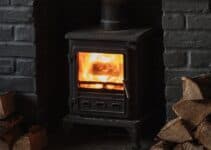As an ardent aficionado of the crackling warmth that a log burner brings to a home, I’ve always been eager to delve into the finer details of its maintenance. I’ve learned that the handling of ash—a seemingly trivial aspect of log burner cleaning—is in fact pivotal in enhancing its performance. So, before you reach for the shovel, consider this: a modest layer of ash inside your wood stove not only serves as a catalyst for efficient burning but also shields your investment from potential damage.
My insights into maintaining the optimal ash bed aim to ensure that your hearth remains a source of both comfort and efficiency. Whether you’re seasoned in the art of log burner maintenance or just beginning, understanding the role of an ash bed will illuminate why a little layer left behind is not just acceptable, but advisable.
Understanding the Role of Ash in Your Log Burner
When it comes to enhancing the functionality of a log burner, many overlook the role of a seemingly mundane by-product: fireplace ash. Yet, it is this ash that significantly contributes to log burner efficiency and performance. Let me take you through the underlying science and its practical application in everyday use.
The Science of Ash Insulation and Heat Reflection
Ash derived from burnt logs isn’t just residue to be discarded. On the contrary, it encapsulates and retains warmth within the fire chamber, enabling heat to be reflected back onto the fuel source. This reflection facilitates the speedier ignition of logs, thereby improving the burn rate and overall heat output. In essence, ash insulation plays a crucial role in maintaining elevated temperatures that are pivotal for efficient energy use.
Optimising Combustion: Secondary Combustion Chambers
Moving beyond its insulating properties, ash contributes to a cleaner and more environmentally friendly burn by forming part of the secondary combustion chamber. Here, it aids in the re-ignition of smoke particles, which results in a more complete burn and reduced emissions. The height of ash insulation is paramount; too little, and the reflective benefit is lost, too much, and it can stifle the necessary oxygen flow for combustion.
Protecting Your Log Burner from Damage
The protective qualities of a consistent ash bed should not be underestimated. Ash acts as a buffer against the potential warping or cracking of the log burner’s base, safeguarding the integrity of the burner even when faced with the high temperatures that come with extensive use. Maintaining a layer of ash can, therefore, be seen as a preventative measure that ensures the longevity and reliability of your stove.
In my exploration of the subject, it becomes clear that the existence, and indeed, the management of ash within a log burner should be seen as both a science and an art form. It is an integral component that impacts log burner performance, ensuring that your cozy fire place is not just a source of warmth, but a pinnacle of home heating efficiency.
Maximising Log Burner Efficiency and Performance
Ensuring the efficiency and performance of a log burner is akin to a carefully choreographed dance—striking just the right balance is key. The secret lies in maintaining the optimal ash level, not just for the protection of the stove’s base, but also to enhance the complete combustion of wood. In my experience, a slight bed of ash can actually contribute to cleaner burns and more effective heat generation.
Striking the Right Balance: Ash Depth Recommendations
While maintaining wood stoves, the recommended depth of ash should be maintained at approximately one inch. This is not an arbitrary number but a measurement that has been found to maintain high temperatures conducive for efficient burning. In this sweet spot, the ash acts as an insulating layer, retaining heat and contributing to the log burner’s overall performance.
As part of log burner ash disposal, it’s useful to create a routine for checking and managing the depth of ash. After each use, once the ashes have cooled, assess whether there’s a need to remove some. If the layer exceeds an inch, gently remove the excess while preserving the insulatory bed. This habit not only sets the stage for optimal performance but also extends the life of your stove.
Ensuring Clean Burns and Airflow Management
I’ve found that successful airflow management hinges on the balance of ash within the burner. Too much ash can stifle the very lifeblood of the fire—the oxygen it needs to burn brightly. Conversely, too little ash can leave the fire struggling to reach adequate temperatures. The air wash systems present in many modern wood stoves are essential for maintaining a clear view through the glass door, and this clarity is best achieved by keeping those optimal ash levels in check.
Day-to-day, the process of maintaining your wood stove involves a pattern of careful observation and moderate cleaning. It’s not a herculean task; rather, it’s a matter of attentive upkeep that rewards you with the comforting crackle of a well-fed flame and the satisfying warmth that only a wood stove can provide.
Should I leave a bed of ash in my log burner?
As a dedicated user and proponent of the humble log burner, I’ve explored various facets of its maintenance to ensure peak performance and longevity. One recurrent question I encounter is whether retaining a bed of ash within a log burner is beneficial. Having accrued substantive insights into the nuances of log burner efficiency, I am convinced that a thin layer of ash can indeed be an ally in harnessing the full potential of your wood stove.
The appropriation of ash within a log burner must be astutely managed; it is a fine balance—a trifle too much, and you impede airflow, too little, and you forfeit the thermal protection it provides. Having delved into the particulars, my approach aligns with conserving a slight yet strategic amount of ash, roughly 25mm, to optimise the combustion process. This practice is not merely anecdotal but is grounded in a practical understanding of the log burner’s mechanics.
Understanding the role ash plays in the operation of your log burner is paramount; it is not simply a by-product of burnt wood but an invaluable contributor to the stove’s efficiency.
- Insulation: An ash bed preserves the radiant heat, expediting the ignition of fresh logs.
- Protection: The metal grate is shielded from extreme heat, which if unchecked, can reduce the stove’s life span.
- Emission Control: Ensuring complete combustion, the ash bed helps in reducing unburnt particulates, thus contributing to a cleaner burn.
- Garden Fertiliser: Beyond its utilitarian role within the burner, fireplace ash can enrich your garden soil with essential nutrients.
This scrutiny of the ash bed suggests that its maintenance could influence not just the immediate warmth of your home but also the proficiency of the log burner in the grander scheme. Adhering to this premise, I have realised the potential to maximise the practicality of the remaining ash, ultimately enhancing the overall efficiency of my wood stove.
| Benefits | Method | Outcome |
|---|---|---|
| Heat Retention | Conserve an ash layer of about 25mm | Faster ignition and sustained burn |
| Stove Protection | Regularly even out the ash bed | Reduced metal fatigue and longevity of stove |
| Cleaner Burn | Encourage complete combustion with optimal ash depth | Lower emissions and more efficient wood usage |
| Repurposing Ash | Apply cool ash to garden soil | Improved soil quality and plant health |
In conclusion, my consistent observation asserts that a minimal layer of ash accumulated at the base of a log burner is not merely acceptable but favoured. It facilitates the log burner’s operation, protects it and can be repurposed to enhance your garden’s soil fertility. The confluence of these factors propels me to recommend an informed and deliberate approach to ash maintenance within your log burner, orchestrating a fine harmony between removal and retention.
Maintaining Your Log Burner: Cleaning and Ash Disposal
As a passionate advocate for optimal home heating, I recognise the crucial role that thorough log burner maintenance plays in both the efficiency and longevity of your fireplace. The process isn’t just about keeping the hearth looking presentable; it directly impacts the air quality and heat output of your home. Let’s delve into the cleaning rituals that make a difference and explore the ingenious ways fireplace ash can be repurposed in the garden.
Regular Cleaning Rituals and Their Importance
Committing to a regular log burner cleaning schedule pays dividends. It’s not only about maintaining the aesthetic appeal; it pre-empts the accumulation of ash that can attract moisture and cause corrosion. Moisture is the enemy of the log burner, potentially leading to acidic damage to the metal and masonry. I recommend adopting a meticulous approach to cleaning, little and often, during busy heating seasons, and conducting a thorough clean at the season’s end.
Utilising Ashes: Garden Fertiliser and Other Uses
There’s more to fireplace ash than meets the eye. Beyond its heat retaining qualities when in the burner, once cool, it becomes a treasure trove of nutrients for your garden. I’ve often used ash as a garden fertiliser, contributing potassium and trace elements to the soil, and moderating its pH levels. Remember, safety comes first, as remnants of live coals may linger amidst the ashes, thus proper disposal methods must be in place.
| Use of Fireplace Ash | Benefits | Tips for Safe Application |
|---|---|---|
| Ash as a garden fertiliser | Rich in potassium and trace elements, it contributes to soil fertility | Ensure the ash is cool and sprinkle lightly around plants |
| Ash for composting | Enhances compost nutrient content and neutralises odour | Mix in small amounts to avoid altering the compost’s moisture balance |
| Pest control | Natural deterrent for snails and slugs | Create a barrier around garden beds with the ash |
| Ice melt alternative | Provides traction on icy paths and is pet-friendly compared to salt | Scatter evenly on walkways, sparingly to protect plant life |
I always advise fellow log burner enthusiasts to consider incorporating a yearly professional chimney sweep into their log burner maintenance routine. This service helps to ensure that all components, including those beyond the reach of day-to-day cleaning, are kept in prime condition, thus safeguarding your household’s cosy fires for years to come.
Conclusion
As we draw the curtain on our discussion about log burner maintenance, I reflect on the cyclic nature of ash management and its critical role throughout the burning season. With the Chimney Safety Institute of America advocating for residue-free burners post-season, it’s evident that your approach to ash should ebb and flow with the seasons. The diligent attention that you’ve given to maintaining an optimal ash bed will seamlessly transition into meticulous cleaning efforts as warmer months approach.
The Seasonal Aspect of Ash Maintenance
Seasonal log burner care extends beyond mere comfort during the colder months; it’s about preparing and preserving your wood stove. As each burning period ends, our focus must adjust from maintaining that essential protective ash layer to guaranteeing our log burner is safeguarded against moisture and the potential corrosive effects of leftover ash. By adhering to this seasonal rhythm, your meticulousness promises both immediate warmth and enduring log burner health.
Long-Term Benefits of Proper Ash Management
Proper ash management transcends mere seasonal upkeep and branches into the arboretum of long-term log burner benefits. As I implement recommended practices, I not only ensure peak performance of my log burner but also play a part in protracting its service life. This commitment to the finer details, such as ash level optimisation, provides a testament to the essence of thorough wood stove care. It’s always wise to consult manufacturer’s guidelines – this tailors your approach to the unique characteristics of your log burner, ensuring its continued efficacy and longevity.


